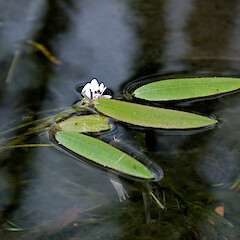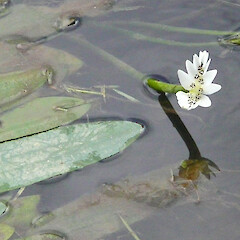Aponogeton distachyos
Common name
Cape pondweed
Synonyms
Aponogeton distachyus
Family
Aponogetonaceae
Flora category
Vascular – Exotic
Structural class
Herbs - Monocots
NVS code
The National Vegetation Survey (NVS) Databank is a physical archive and electronic databank containing records of over 94,000 vegetation survey plots - including data from over 19,000 permanent plots. NVS maintains a standard set of species code abbreviations that correspond to standard scientific plant names from the Ngä Tipu o Aotearoa - New Zealand Plants database.
APODIS
Conservation status
Not applicable
Brief description
Bottom rooted perennial aquatic plants that grows in water up to 1.2m deep with floating oval dark green leaves and attractive and fragrant flowers with white petals that extend above the water surface. Plants also have submerged leaves and large tuberous rootstock.
Distribution
Widely naturalised, though apparently lost from some northern sites. Some locally abundant populations in coastal and lowland NI localities. Occurs in SI at Blenheim in Marlborough, in some lakes in Canterbury and Westland, near Dunedin and near Lake Te Anau.
Habitat
Still and flowing water bodies.
Wetland plant indicator status rating
Information derived from the revised national wetland plant list prepared to assist councils in delineating and monitoring wetlands (Clarkson et al., 2021 Manaaki Whenua – Landcare Research Contract Report LC3975 for Hawke’s Bay Regional Council). The national plant list categorises plants by the extent to which they are found in wetlands and not ‘drylands’. The indicator status ratings are OBL (obligate wetland), FACW (facultative wetland), FAC (facultative), FACU (facultative upland), and UPL (obligate upland). If you have suggestions for the Wetland Indicator Status Rating, please contact: [Enable JavaScript to view protected content]
OBL: Obligate Wetland
Almost always is a hydrophyte, rarely in uplands (non-wetlands).
Detailed description
Cape pondweed has a basal globose (nearly spherical) tuber, 3-4 cm in diameter. Floating leaves are basal, pale to dark green, up to 25 cm long, narrow-lanceolate in shape, and with many distinctive cross veins. Submerged leaves are linear in shape. The tuberous rootstock has a ring of long soft roots and fibrous remains from petioles. Flowers are on a two-forked spike with fleshy white lobes and are very fragrant. The terminal spikes (ca 6 cm long) protrude above the water and have a tubular spathe that sheaths the infloresence and falls off at an early stage . Flowers are sessile (no stem) in two rows and fragment at the base of the bract-like extensions of the spike axis. These bract-like extensions enlarge (ca 1cm) and become reddish at fruiting. Seeds are ca 9 mm long with a green spongy outer testa. Seedlings have terete/circular leaves and proressively acquire minature oblong leaves. When only a few centimetres high the seedling develops its characteristic basal tuber, and the testa remains attached to the seedling for a considerable period.
Similar taxa
Swamp lily (Ottelia ovalifolia). Swamp lily has fibrous roots compared with the tuberous rootstock of Cape pondweed. Swamp lily floating leaves are less elongated, with pronounced dark green venation and flowers are three-petalled.
Flowering
Predominantly Decemeber, but spring to autumn.
Flower colours
White
Fruiting
Autumn
Life cycle
Seeds prolifically, seeds water dispersed. Ripe fruit can float for a short time before release of the negatively buoyant seeds and in flowing water the plant can be dispersed over considerable distance.
Year naturalised
1870
Origin
South Africa
Reason for introduction
Probably planted as an ornamental because of its attractive, fragrant flowers.
Control techniques
Can be controlled manually, mechanically or herbicidally depending on situation.
Etymology
aponogeton: From the Celtic apon ‘water’ and ‘geiton’ neighbour. An alternative etymology is that this word is from the Greek a- ‘without’ or ‘lacking’ and ge ‘earth, i.e. aquatic
distachyos: From the Greek dis ‘two’ and takeon ‘spike’, in reference to the V-shaped flower spike.
Attribution
Factsheet prepared by Paul Champion and Deborah Hofstra (NIWA).
References and further reading
Champion et al (2012). Freshwater Pests of New Zealand. NIWA publication. http://www.niwa.co.nz/freshwater-and-estuaries/management-tools/identification-guides-and-fact-sheets/freshwater-pest-species.
Johnson PN, Brooke PA (1989). Wetland plants in New Zealand. ; DSIR Field Guide, DSIR Publishing, Wellington. 319pp.
Coffey BT, Clayton JS (1988). New Zealand water plants: a guide to plants found in New Zealand freshwaters. Ruakura Agricultural Cente. 65pp.
Popay et al (2010). An illustrated guide to common weeds of New Zealand, third edition. NZ Plant Protection Society Inc, 416pp.
Johnson, A. T., Smith, H. A. (1972). Plant Names Simplified: Their pronunciation, derivation and meaning. Landsman Bookshop Ltd: Buckenhill, UK.



